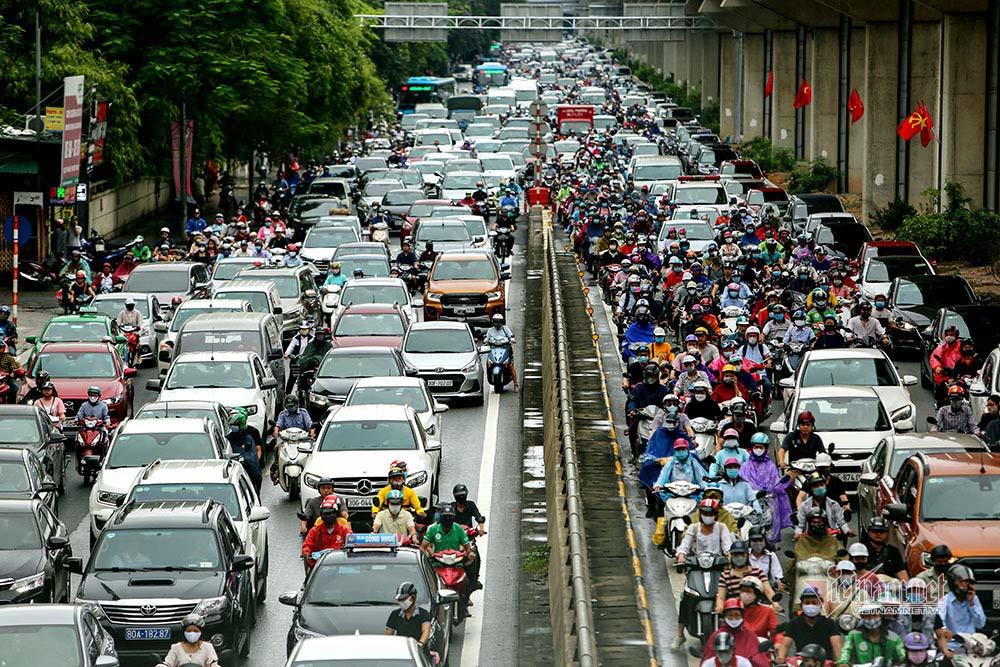 |
| A traffic jam in Hanoi. — VNA/VNS Photo Minh Hieu |
According to the plan proposed by Hanoi Public Transport Management Centre, car drivers will have to pay between VND50,000-100,000 (US$2.2 - US$4.4) to enter downtown areas on ordinary days.
Toll fees would change depending on time frames. Time frames with low traffic density would require a small or no toll fee. There would also be no toll fees during the weekends and holidays. The plan places 87 toll booths at 68 locations within Ring Road 3, situated on traffic routes leading towards downtown Hanoi.
A similar toll fee plan was introduced in HCM City recently in which cars entering the city centre during peak times, 6am - 9am and 3pm - 7pm, have to pay VND40,000-70,000 per entry.
Chief of the Office of the National Traffic Safety Committee, Tran Huu Minh, said that the policy of collecting tolls from private vehicles when entering city centres is used in many countries; in London for example, drivers paid about $20 a day to enter the city centre.
In Vietnam, large cities like Hanoi and HCM City had been exploring solutions to improve traffic conditions.
However, Minh said that it was still too early to evaluate whether or not the application of toll fees is the solution, due to a lack of evidence.
“Before imposing toll fees on cars entering the inner city, the city first needs to assess the impact of the policy and calculate the speed of vehicle growth, particularly how it will impact road users,” he said.
“Every solution has pros and cons, so the government needs to rely on specific data to consider. If it proves the outstanding benefits of the new fee collection, it should be implemented,” Minh said.
Nguyen Van Quyen, Chairman of the Vietnam Automobile Transport Association, said that if the toll collection was implemented, car owners with strong finances will still use cars to enter the inner city, but those with less access to funds will probably switch to using motorbikes. This would affect the city's long-standing policy of reducing personal vehicles, including motorbikes, in the inner city.
Bui Danh Lien, former chairman of the Hanoi Transport Association, said that collecting toll fees from cars that enter the city centre is a financial tool to reduce traffic congestion in the city.
He added that car toll collections should be implemented only when public transport can meet at least 50 per cent of people's travel needs.
“Currently, the rate of public passenger transport in Hanoi is only 12 per cent. Personal vehicles are prefered. Without sufficient public transportation, is it reasonable to impose an additional toll fee for private cars?” Lien asked.
Nguyen Trong Thong, Chairman of the Hanoi Public Passenger Transport Association, said that as of 2021, Hanoi has more than 120 bus routes, one BRT line (Yen Nghia-Kim Ma) and two urban railway lines that have not been put into operation.
Thong said that the city plans to collect tolls from cars entering the inner city, but the public passenger transport system has received little attention for further development as an alternative to private transport. An initiative on prioritising bus routes was proposed in 2016, but it has not been approved by the city so far.
"If public transport serves people's needs well, they will no longer use their personal cars," Thong said.
Nguyen Xuan Thuy, a transport expert and former Director of Transport Publishing House, said that HCM City and Hanoi has a few urban railway lines and metros, but they still lack connectivity with other transportation modes. Buses are unable to meet people’s travelling demands, especially when personal vehicles were restricted.
“Motorbikes and cars are still the main means of transportation that people in the cities choose,” he said.
"Only when public transport is better developed and transport infrastructure is improved will people give up personal vehicles. The State and businesses must strengthen the construction of a public transport system that serves the needs of the public," Thuy added.
Nguyen Van Thanh, former Deputy Director of the Directorate for Roads of Vietnam, said that it was necessary to focus on transparency when it came to toll collection, as well as the management and use of the collected fees.
“People must be provided with detailed information about the fees as well as an implementation roadmap on how the collected fees are used. The necessity, effectiveness and benefits of the car toll collection need to be clearly laid out for people,” Thanh said.
The car toll collection plan will be evaluated by Hanoi People’s Council, the city's legislature, by the end of 2021.
According to the city’s Transport Department, Hanoi currently has around 6.4 million vehicles, 5.6 million of which are motorbikes. There are around 600,000 cars, plus another two million other vehicles, from outside Hanoi.
Source: Vietnam News

Hanoi plans to build 87 toll booths in inner city areas to ease traffic congestion
To ease traffic congestion in the city hub, the Hanoi Department of Transport has worked out a plan to install 87 toll stations on ring roads.